
|   |

|   |
Chennai Culture Juggernaut - Lalitha Venkat e-mail: lalvenkat@yahoo.com September 5, 2013 There has been a lot of cultural activity in Chennai in the last 2 months including some long winding arangetram programs where the lucky young debut making dancers were accompanied by some top musicians. From 6 to almost 10pm including dinner, 3 to 5 costume changes, long announcements, reminiscences, many chief guests who all have to deliver positive speeches, an arangetram program nowadays rather tests the patience of the invited guests. In fact, when one is invited for an arangetram, nowadays it is automatic to ask if there is dinner too after the show! It was nice to know that Tamilnadu Eyal Isai Nataka Manram was hosting a 3 day festival of music and dance of Odisha at 3 different venues from Aug 22 – 24, 2013 so I decided to go to Bharatiya Vidya Bhavan in Mylapore on the inaugural day and meet my friends from Odisha as well as see them perform. It was a rather dismal affair with a garish banner filling the whole backdrop and more press persons/photographers filling the auditorium than rasikas, and more people from the organiser’s side on the stage than in the hall. Due to traffic snarls and prior engagements, we had to wait for an hour for the minister, who was chief guest, to arrive. This was followed by the inevitable speeches, two rounds of garlanding the dignitaries on the dais as well as exchanging mementoes and shawls. Here, these are necessary protocols to be followed when government dignitaries are involved! So, when the show finally commenced, it was 7.45pm and soon the tired audience of some locals who had dropped in to enjoy the a/c, and hopefully the show too, started the slow exodus. Headed by Chittaranjan Mallia (Secretary, Odisha Sangeet Natak Akademi), the program featured a much applauded Gotipua dance by disciples of Bijaya Kumar Sahoo, Odissi by Meera Das, energetic Sambalpuri dance by disciples of Bipin Bihari Das and finally, Odishi vocal by Prof. Ramhari Das, each performance being of 20 minutes duration. A popular dance guru confided that she found from personal experience that Chennai rasikas always seemed to flock to programs or workshops of local dancers but they did not seem to be that enthusiastic when it came to programs or workshops by dancers from outside Chennai. However, the shows at Eyal Isai Nataka Manram and Krishna Gana Sabha went off very well on the subsequent evenings. 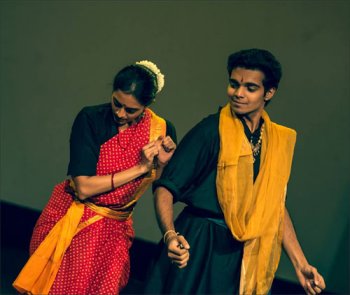 Lakshmi Parthasarathy Athreya & Bhavajan Kumar 
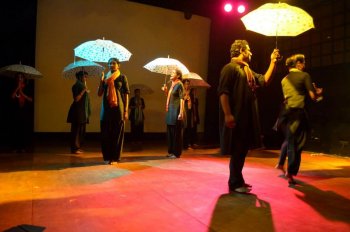
Subverse
On August 25 and 26, JustUs Repertory presented SUBVERSE, poems on the underground, designed and directed by Gowri Ramnarayan at Alliance Francaise. Gowri has developed her own style of theatre that includes music, dance and poetry. The cast of Aarabhi Veeraraghavan, Akhila Ramnarayan, Bhavajan Kumar, Deepa Chakravarthy, Gheerthiga Subramaniam, T Hari, Lakshmi Parthasarathy Athreya, Manasvini Ramachandran, Sandeep John, Rahul Sridhar, Sunanda Raghunadhan and P Thilagavathy danced, sang, acted and orated poetry. Presented in 9 segments with an English poem followed by a thematically suitable poem in an Indian language that was danced to, the 90 minute program moved effortlessly from one segment to another with lightning changes of costume accessories. There was a bit of Bharatanatyam, a bit of Mohiniattam and even “singing in the rain” type of scene with umbrellas. Akhila provided vocal accompaniment, switching from actor to singer while Sandeep John sang or strummed his guitar for some numbers. If Gowri was a bit disappointed about the audience turnout for the first evening, she must have been more than happy with the full house on the second evening. What inspired Gowri to do Subverse and what did the dramatization process entail? “The reason I wanted to do it now was to work with newcomers to the stage - like Rahul Sridhar and Tippirajapuram Hari (Schoolboy mridangam player), or dancers like Lakshmi Parthasarathy, Deepa Chakravarthy, Manaswini Ramachandran or Bhavajan Kumar who wanted to do theatre, or a guitarist like Sandip John who learnt to sing Indian music. I thought Subverse will give me an opportunity to find new actors and performers. I saw it as a workshop production. I do really long term rehearsals. But this time I decided on 12 sessions in a single month, and run through the whole several times before the show. I had individual sessions with the performers. For the newcomers it was really difficult to learn to move naturally on the stage, to speak naturally, and to project their voices. It was a challenge to make poems sound like dialogue. And to make the narration sound like conversation with the audience. They had to develop a sense of drama, of timing and continuity. What made Subverse different was that all performers were equal participants in acting, dancing, singing and changing props. They had to become adept at lightning changes of costume, scene, character and period. It was group work in every sense. They had to develop team spirit, and responsibility for the whole, not just their parts. It was a rare opportunity to work with great poetry spanning 2000 years, many languages across the globe, and in a multi-genre production. Imagine discovering an ancient verse from the Sangam age sounding urgently contemporary, and a new poem by Nigerian poet Niyi Osundare gripping us with a timeless appeal! Also, what an experience to plunge into every kind of rasa from the terrifying to the hilarious! What made Subverse special was that each person could not only do his or her best with what they knew, what they were trained in, but also stretch themselves by doing unfamiliar things. They could bring their skills and learn new skills. They could exercise their imagination. It was a democratic process. Everyone had great fun. In many ways Subverse has been the most enjoyable work I have done - we have discovered and pushed ourselves in new directions as we cannot do with a more "set" work. It was an exploratory process for the individual and the group.” Is there a plan to stage it again? “Yes, we can, if someone invites us to do so. I would love to stage it in schools. I think the poem-performance will be hugely enjoyed by the young, introduce them to many worlds, and make them think about the values we prize in life,” says Gowri. 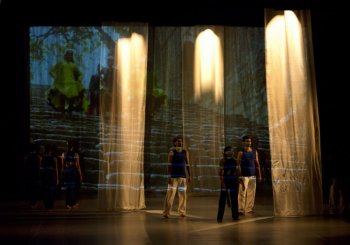 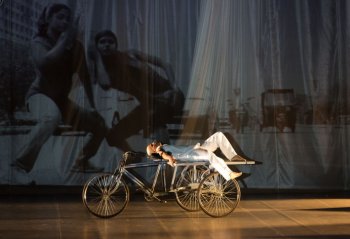
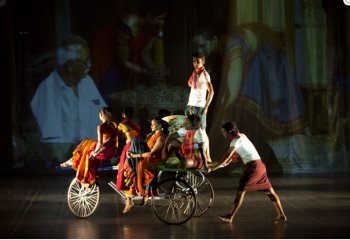
Aadhaara Chakra
Pics: <bl For the Park’s New Festival, Prakriti Foundation with the support of Goethe Institut, chose to stage Bangalore based Attakkalari’s latest multi-media dance production ‘AADHAARA CHAKRA: A DANCELOGUE’ choreographed by Jayachandran on August 29 at a warehouse (owned by the festival’s artistic director Ranvir Shah’s family) in Thoraipakkam on the outskirts of Chennai. Because of the distance, buses had been arranged and there was a very good turnout for the program that was to start at 8pm, rather late by Chennai standards. Because of too many traffic jams, it finally started at 8.30pm but no one cared as the ambience in the huge warehouse was all festive. All focus was on the wide, low dais with a white backdrop (courtesy Victor Paulraj and team) for screening images, some surreal and some from real life of the repertory company and the team of international collaborators travelling in India. They danced in traditional costumes or posed on location in a Tiruvannamalai market place alongside vendors, courtyard of a Karaikudi house, train station, fields, in the Chidambaram temple and also the Qutab Minar, Humayun`s Tomb and Ugrasen ki Bowli (ancient step wells), with sounds from temple or mosque resounding in the background, streets and markets of Delhi, riding bikes on the boulevard leading up to India Gate and the Rashtrapathi Bhavan. Against this backdrop, Jayachandran’s participation was almost like a guest appearance while the performers switched between traditional to contemporary costumes, the movements being influenced by the music. There was even a folk dance to snatches of a popular Tamil song. “Music composers Sam Auinger and Martin Lutz modulate classical Indian music, hawkers’ cries and popular cinematic strains filtered through electronica processes to create a provocative soundscape.” We even saw a cart being pedaled on stage and the dancers sitting on it with their huge baskets as one sees generally on the street or in village roads. It was a tough choice to follow the video projection as well as concentrate on the moving dancers. The performance is said to have been inspired from the idea of travelogues and the audience sat riveted through the 60 minutes of journeying with the dancers. No one cared that it was sweltering hot as the many fans provided were inadequate more so because some individuals parked themselves in front of the fans effectively preventing the breeze from circulating. The performance was followed by dinner in the other part of the hall. It was an interesting evening where performance in this new space opened out possibilities of experimenting with other spaces besides auditoriums. It was a welcome change with people already wondering what could be held here at a later date. And it also proved that people in Chennai actually did not mind traveling so far to see a contemporary dance performance. 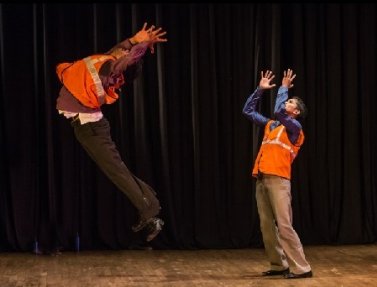
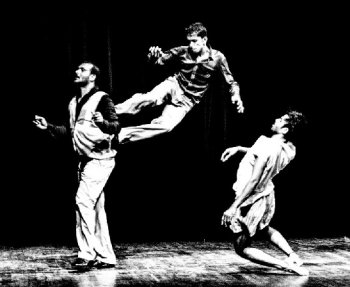
NH7
Deepak Kurki Shivaswamy along with CS Charan and Amaresha Kempanna of
the Kha Foundation (a collective based in Bangalore) presented ‘NH7’ as a
‘contemporary dance trio’ for The Park’s New Festival at Museum
Theatre, Chennai, on Aug 30. As winners of the Prakriti Excellence in
Contemporary Dance Awards (PECDA) last year, the group won mentorship
with the Akram Khan Dance Company. I had seen the work in progress
choreographed by Deepak last year in Chennai and the finished product
running to 45 minutes was so different. The production explored
the agriculture scenario in India and the rapid migration of people from
rural to urban areas in search of a better life but what they see “is a
mad need to build, demolish and re-imagine the city.” Clad in dhotis
and vivid color shirts, the performers engage in agriculture activities,
then turn their back to the audience and covered by the dhoti, change
into trousers to signify their urban avatar, ending in becoming slaves
to the corporates. Drinking coke from a can, Charan stands triumphantly
on the back of Amaresha and Deepak who carry a shoe each on their heads,
completing the picture. The performance had a very current topic as
theme and there were some interesting movements. Music was by Abhijeet
Tambe and Manu Shrivastava and lighting by Jagadeesh Nanjundappa.The next morning at the discussion forum at Max Mueller Bhavan, Deepak spoke about the difficulty of getting space for rehearsing NH7. “We used to rehearse even in parks. When we discovered that ‘A1000yoga’ in Bangalore was vacant for a few hours, we requested them to lend their space for our rehearsal at a nominal cost that we could afford and promised to acknowledge them in our publicity. They agreed and we had 3 months of rehearsal without getting stressed out. People are generous if you persist,” said Deepak with a smile. Apart from choreographing ‘NH7,’ why did Deepak also perform in it? “I insert myself into the group only if I feel it is necessary and a different body would not suit the existing group.” Lalitha Venkat is the content editor of narthaki.com |